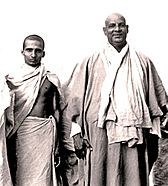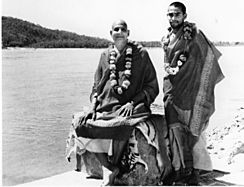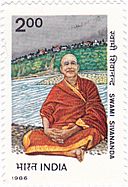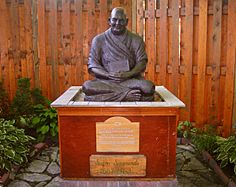Sivananda Saraswati facts for kids
Quick facts for kids Sivananda Saraswati |
|
|---|---|
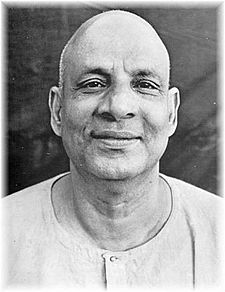 |
|
| Birth Date | 8 September 1887 Pattamadai, Madras Presidency, British India (now in Tamil Nadu, India) |
| Died on | 14 July 1963 (aged 75) Muni Ki Reti, Uttar Pradesh, India (now in Uttarakhand, India) |
| Birth name | Kuppuswami |
| Guru/teacher | Vishwānanda Saraswati |
| Philosophy | Yoga of Synthesis |
Swami Sivananda (born Kuppuswami; 8 September 1887 – 14 July 1963) was an important yoga teacher and Hindu spiritual leader from India. He taught about Vedanta, a type of Hindu philosophy.
Sivananda was born in a village called Pattamadai in Tamil Nadu, India. Before becoming a spiritual teacher, he studied medicine and worked as a doctor for many years in British Malaya (now Malaysia).
He started the Divine Life Society in 1936. This group helps people learn about yoga and spiritual living. He also wrote over 200 books about yoga, philosophy, and other topics. Swami Sivananda lived most of his life at the Sivananda Ashram, which is the main center for the Divine Life Society. It is located near the Ganges River in Rishikesh, India.
Today, a style of yoga called Sivananda Yoga is taught around the world. It was made popular by one of his students, Vishnudevananda.
Contents
About Swami Sivananda
His Early Life
Swami Sivananda was born on 8 September 1887. His birth name was Kuppuswami. He was born into a brahmin family in a village called Pattamadai, near the Tamraparni River in Tamil Nadu. His father, Sri P.S. Vengu Iyer, was a government officer and a devoted follower of the Hindu god Shiva. His mother, Srimati Parvati Ammal, was also very religious. Kuppuswami was the youngest of their three children.
As a child, he was very active and good at school and sports. He went to medical school in Tanjore and did very well. While studying, he even ran a medical magazine called Ambrosia.
After finishing medical school, he worked as a doctor in British Malaya for ten years. He was known for giving free treatment to poor patients. However, he started to feel that medicine only healed the body, not the spirit. This feeling made him want to find a deeper purpose. So, in 1923, he left Malaya and returned to India to begin his spiritual journey.
Becoming a Monk
When he came back to India in 1924, Kuppuswami went to Rishikesh, a holy city. There, he met his spiritual teacher, Vishvananda Saraswati. His teacher gave him a new name, Sivananda, and welcomed him into the Sannyasa order, which is a group of Hindu monks. The full ceremony was done by Vishnudevananda, who was the head of Sri Kailas Ashram.
Sivananda decided to stay in Rishikesh. He spent many years practicing intense spiritual exercises. He also continued to help sick people. In 1927, he used some money from an insurance policy to open a free clinic at Lakshman Jhula.
Starting the Divine Life Society
In 1936, Sivananda started the Divine Life Society near the Ganges River. He gave away spiritual books and teachings for free. Some of his first students included Satyananda Saraswati, who later started his own yoga school.
Over the years, Sivananda created more organizations. In 1945, he opened the Sivananda Ayurvedic Pharmacy, which uses traditional Indian medicine. He also organized a meeting for all world religions. In 1947, he started the All-world Sadhus Federation, a group for holy people. In 1948, he founded the Yoga-Vedanta Forest Academy.
He called his teachings the Yoga of Synthesis. This means he combined the four main types of Yoga from Hinduism:
- Karma Yoga (yoga of action)
- Bhakti Yoga (yoga of devotion)
- Jnana Yoga (yoga of knowledge)
- Rāja Yoga (yoga of meditation)
He believed that combining these paths helped people grow in all parts of their lives.
In 1950, Sivananda traveled a lot across India. He opened many branches of the Divine Life Society. He worked hard to share his ideas about yoga with everyone. Some people called him "Swami Propagandananda" because he spread his message so widely. His student, André Van Lysebeth, explained that critics didn't like his modern ways of sharing yoga with many people. Sivananda wanted everyone to be able to practice yoga, combining simple exercises, breathing, meditation, and devotion.
Why He Was a Vegetarian
Sivananda strongly believed in eating a strict lacto-vegetarian diet. This means eating no meat, fish, or eggs, but allowing dairy products. He felt it was important for both moral and spiritual reasons. He also said that "meat-eating is highly harmful to health." Because of his beliefs, the Divine Life Society encourages everyone to follow a vegetarian diet.
His Passing
Swami Sivananda passed away on 14 July 1963. He entered what is called Mahasamadhi, which in yoga means a great yogi consciously leaves their body. This happened by the Ganges River at his Sivananda Ashram near Muni Ki Reti.
His Students
Swami Sivananda had many students who continued his work. His two main students who helped run the Divine Life Society were Chidananda Saraswati and Krishnananda Saraswati. Chidananda Saraswati became the president of the Divine Life Society in 1963 and served until his death in 2008. Krishnananda Saraswati was the General Secretary from 1958 until his death in 2001.
Many other students also started their own important organizations:
- Chinmayananda Saraswati, who founded the Chinmaya Mission
- Karunananda Saraswati, who started The Valley of Peace yoga ashram in Australia
- Sahajananda Saraswati, the Spiritual Head of Divine Life Society of South Africa
- Satchidananda Saraswati, who founded the Integral Yoga Institutes around the world
- Satyananda Saraswati, who founded Bihar School of Yoga
- Shantananda Saraswati, who founded Temple of Fine Arts in Malaysia and Singapore
- Sivananda Radha Saraswati, who founded Yasodhara Ashram in British Columbia, Canada
- Venkatesananda Saraswati, who inspired ashrams in South Africa and Australia
- Vishnudevananda Saraswati, who founded the Sivananda Yoga Vedanta Centres
His Books
Sivananda wrote 296 books on many different topics. These included books about philosophy, yoga, religion, psychology, ethics, education, and health. He also wrote poems, stories, and his own life story. His books focused on how to actually use yoga philosophy in daily life, rather than just learning about it in theory.
See also
 In Spanish: Swami Sivananda para niños
In Spanish: Swami Sivananda para niños


